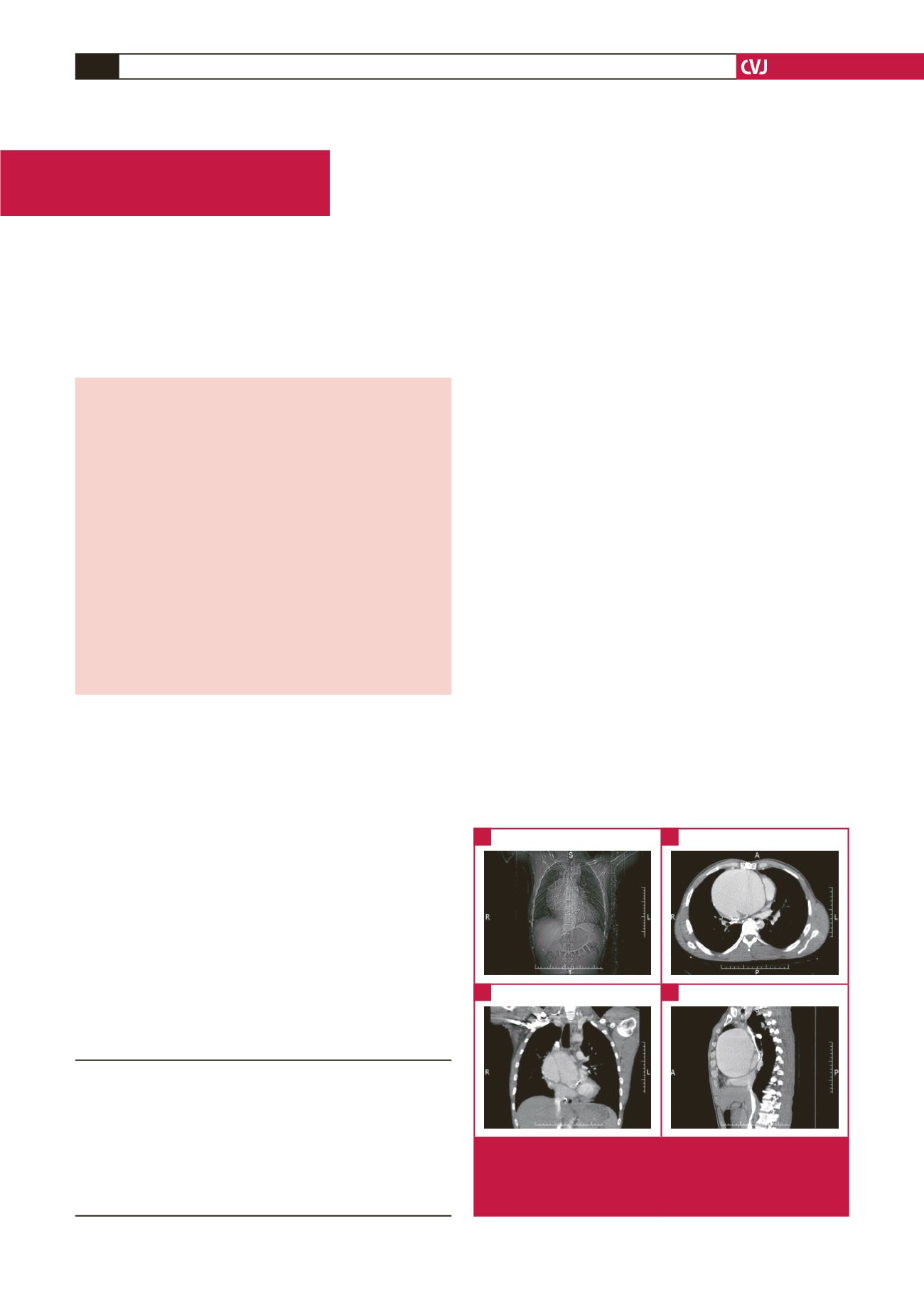

CARDIOVASCULAR JOURNAL OF AFRICA • Volume 28, No 4, July/August 2017
e6
AFRICA
Case Report
Management of a complicated redo giant dissecting
aortic aneurysm
Ibrahim Kara, Alper Erkin, Halil Ibrahim Erkengel, Kıyasettin Asil
Abstract
Giant aortic aneurysm is defined as an aneurysm of the aorta
of greater than 10 cm in diameter. This rare condition is asso-
ciated with a high risk of morbidity and mortality and it may
lead to fatal complications such as rupture and/or dissection
if not managed with proper surgical planning and expertise.
Other than atherosclerosis, the main causes of giant ascend-
ing aortic aneurysms include Marfan and Ehlers–Danhlos
syndromes. Herein we report on a young male patient who
had had an aortic valve replacement five years earlier due to
a bicuspid aortic valve leading to aortic failure, accompanied
by aortic coarctation. He had an aneurysmal expansion rate
of 1.81 cm/year to reach a final aneurysmal diameter of
13.25 cm, which, to our knowledge, represents the largest size
ever reported in the literature for such lesions, and in which
the redo and aneurysmal wall were adjacent to the sternal
margins.
Keywords:
giant aortic aneurysm, surgical procedures
Submitted 19/5/16, accepted 28/9/16
Cardiovasc J Afr
2017;
28
: e6–e8
www.cvja.co.zaDOI: 10.5830/CVJA-2016-087
Giant aortic aneurysm is a very rare clinical entity defined as an
aneurysm of the aorta that is greater than 10 cm in diameter at its
widest point.
1
The risk of rupture closely parallels the diameter
of the aneurysm, with a rupture risk of 31% in lesions in which
the diameter of the ascending aorta is greater than 6 cm.
2
Other
main causes of ascending aortic aneurysms include Marfan
and Ehlers–Danlos syndromes, in addition to atherosclerosis.
1
Although the risk of dissection and/or aneurysm is lower in
patients with a bicuspid aortic valve (BAV) than in patients with
Marfan syndrome, the former condition bears higher clinical
significance based on its much higher incidence.
3
Bicuspid aortic valve is a congenital condition requiring early
valvular replacement due to accelerated valvular degeneration.
It is a serious disorder of the aorta, frequently co-existing with
dilation and rapid expansion of the ascending aorta. Therefore
the ascending aorta should be regarded as a component of the
pathology, and the type of surgical method to be performed
should be carefully assessed in BAV patients requiring surgical
intervention.
4
Here we report on a young male patient who developed
a giant ascending aortic aneurysm of 13.25 cm, against a
background of the very rare occurrence of a chronic dissection
five years after a valvular replacement that had been performed
due to BAV failure.
Case report
A 33-year-old male patient was admitted to the emergency
room with headache, shortness of breath and sleeplessness. A
consultation was requested from our unit due to extreme aortic
and mediastinal dilatation, seen on chest X-ray (Fig. 1A) as
well as a history of open-heart surgery. The patient had had a
mechanical aortic valve replacement (23 no St Jude) five years
earlier due to BAV failure.
Department of Cardiovascular Surgery, Faculty of
Medicine, Sakarya University, Sakarya, Turkey
Ibrahim Kara, MD,
ikara7881@hotmail.comAlper Erkin, MD
Halil Ibrahim Erkengel, MD
Department of Radiology, Faculty of Medicine, Sakarya
University, Sakarya, Turkey
Kıyasettin Asil, MD
Fig. 1.
Mediastinal widening seen in pre-operative chest radi-
ography (A). Pre-operative thoracic CT scan: axial (B),
coronal (C) and sagittal (D) views showing the giant
dissecting aortic aneurysm of 13.25 cm in diameter.
A
C
B
D

















